Chapter 8 课堂教学的技巧- 4
教师说课的教学经验和心得分享

培养学生自主学习能力
教会学生学习方法,引导他们制定学习计划、监 控学习进度、评估学习效果,培养他们的自主学 习能力。
鼓励学生创新实践
提供创新实践的平台和机会,鼓励学生勇于尝试 、敢于创新,培养他们的创新意识和实践能力。
THANKS
关注教育教学改革动态
及时了解政策动向
关注教育部门发布的最新教育教学改革政策,了解改革方向和重 点。
学习先进教育理念
通过阅读教育类期刊、参加学术研讨会等方式,学习国内外先进的 教育理念和教学方法。
积极参与改革实践
在教育教学中积极尝试新的教学方法和手段,参与学校的教学改革 项目,贡献自己的力量。
积极探索创新教学模式和方法
教师说课的教学经验和心得分 享
目录
CONTENTS
• 引言 • 课前准备与教学设计 • 课堂教学方法与技巧 • 课后反思与持续改进 • 与同行交流合作与分享经验 • 对未来教学的展望与建议
01
CHAPTER
引言
目的和背景
提高教学质量
促进教师专业成长
通过分享教学经验和心得,促进教师 之间的交流和学习,进而提高整体教 学质量。
及时反馈,强化兴趣
对学生的表现和进步给予及时的肯定和反馈,增强他们的自信心和 学习兴趣。
采用多样化的教学方法和手段
01
02
03
04
讲解法
通过教师的系统讲解,使学生 掌握基本概念和原理。
讨论法
组织学生进行小组讨论或全班 讨论,促进思想交流和合作学
习。
案例法
引入典型案例,引导学生分析 和解决问题,提高他们的分析
2024年译林版英语四年级上册全册教案
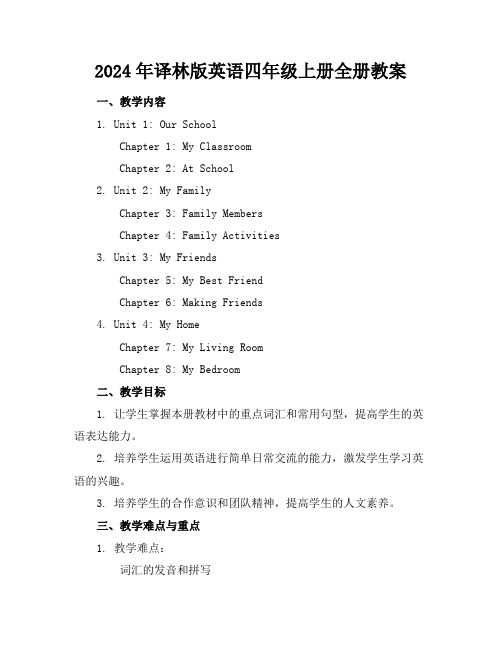
2024年译林版英语四年级上册全册教案一、教学内容1. Unit 1: Our SchoolChapter 1: My ClassroomChapter 2: At School2. Unit 2: My FamilyChapter 3: Family MembersChapter 4: Family Activities3. Unit 3: My FriendsChapter 5: My Best FriendChapter 6: Making Friends4. Unit 4: My HomeChapter 7: My Living RoomChapter 8: My Bedroom二、教学目标1. 让学生掌握本册教材中的重点词汇和常用句型,提高学生的英语表达能力。
2. 培养学生运用英语进行简单日常交流的能力,激发学生学习英语的兴趣。
3. 培养学生的合作意识和团队精神,提高学生的人文素养。
三、教学难点与重点1. 教学难点:词汇的发音和拼写句型的运用和语法结构2. 教学重点:基本词汇和句型的掌握口语表达能力的培养四、教具与学具准备1. 教具:教材、教学课件、录音机、磁带、卡片等。
2. 学具:课本、练习册、文具、卡片等。
五、教学过程1. 导入:创设生活情境,引导学生用英语进行自我介绍,回顾已学知识。
2. 新课呈现:通过图片、故事、对话等形式,呈现新知识,引导学生学习。
3. 例题讲解:对重点句型和语法进行讲解,配合实例,帮助学生理解。
4. 随堂练习:设计各种形式的练习,巩固所学知识,提高学生的运用能力。
5. 小组活动:组织学生进行小组讨论和角色扮演,培养学生的合作意识和口语表达能力。
六、板书设计1. 2024年译林版英语四年级上册全册教案2. 主要内容:每个单元的主题和重点句型、词汇例题和答案学生作品展示七、作业设计1. 作业题目:Unit 1: 画出你的教室,并用英语描述。
Unit 2: 介绍你的家庭成员,并用英语描述他们的特点。
教学论课件ppt

总结词
需要良好的实验条件和设 备
详细描述
实验法需要学校具备相应 的实验条件和设备,以确 保实验的顺利进行和有效 性。
情境模拟法
总结词
模拟实际情境的教学方法
01
总结词
提高学生解决问题的能力
03
总结词
促进团队合作与沟通
05
02
详细描述
情境模拟法是一种模拟实际情境的教学方法 ,通过模拟真实的场景和问题,使学生亲身 体验并解决实际问题。
在线教育平台与资源
在线教育平台是指提供在线学习服务的平台,如 MOOC、网易云课堂等。
在线教育平台可以帮助学生自主安排学习进度,提高学 习效果。
在线教育平台可以提供丰富的课程和学习资源,满足学 生多样化的学习需求。
在线教育平台需要教师具备一定的在线教学能力和课程 设计能力,以保证教学质量和效果。
CHAPTER 05
讨论法
01
总结词
激发思维活跃
02
03
04
详细描述
讨论法能够激发学生的思维活 跃性,培养学生的批判性思维
和解决问题的能力。
总结词
需要良好的组织与管理
详细描述
讨论法需要教师具备良好的组 织和管理能力,以确保讨论的
顺利进行和有效。
案例分析法
总结词
基于实际案例
详细描述
案例分析法是一种以实际案例为基础 的教学方法,通过对案例的分析、讨 论和总结,使学生掌握相关知识。
讲授法
总结词
传统的教学方法
详细描述
讲授法是一种以教师讲授为主的教学方法,通过教师对知识的系统讲解,使学生 了解和掌握知识。
讲授法
总结词
适合大班教学
详细描述
典范英语8-04 布莱克·丹
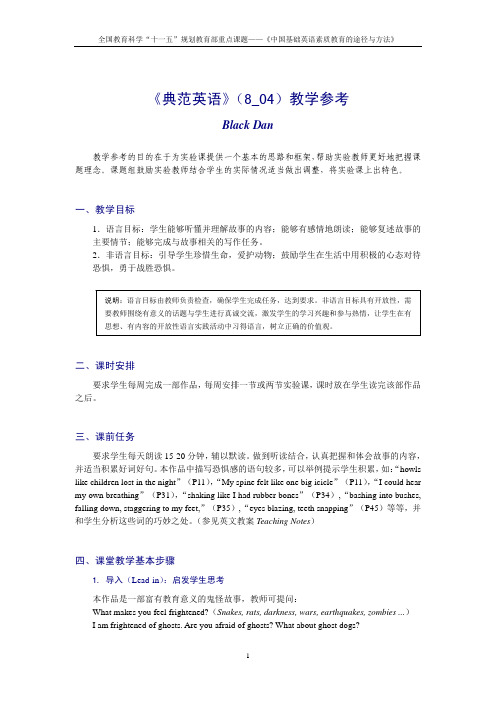
《典范英语》(8_04)教学参考Black Dan教学参考的目的在于为实验课提供一个基本的思路和框架,帮助实验教师更好地把握课题理念。
课题组鼓励实验教师结合学生的实际情况适当做出调整,将实验课上出特色。
一、教学目标1.语言目标:学生能够听懂并理解故事的内容;能够有感情地朗读;能够复述故事的主要情节;能够完成与故事相关的写作任务。
2.非语言目标:引导学生珍惜生命,爱护动物;鼓励学生在生活中用积极的心态对待恐惧,勇于战胜恐惧。
说明:语言目标由教师负责检查,确保学生完成任务,达到要求。
非语言目标具有开放性,需要教师围绕有意义的话题与学生进行真诚交流,激发学生的学习兴趣和参与热情,让学生在有思想、有内容的开放性语言实践活动中习得语言,树立正确的价值观。
二、课时安排要求学生每周完成一部作品,每周安排一节或两节实验课,课时放在学生读完该部作品之后。
三、课前任务要求学生每天朗读15-20分钟,辅以默读。
做到听读结合,认真把握和体会故事的内容,并适当积累好词好句。
本作品中描写恐惧感的语句较多,可以举例提示学生积累,如:“howls like children lost in the night”(P11),“My spine felt like one big icicle”(P11),“I could hear my own breathing”(P31),“shaking like I had rubber bones”(P34),“bashing into bushes, falling down, staggering to my feet,”(P35),“eyes blazing, teeth snapping”(P45)等等,并和学生分析这些词的巧妙之处。
(参见英文教案Teaching Notes)四、课堂教学基本步骤1. 导入(Lead-in):启发学生思考本作品是一部富有教育意义的鬼怪故事,教师可提问:What makes you feel frightened?(Snakes, rats, darkness, wars, earthquakes, zombies ...)I am frightened of ghosts. Are you afraid of ghosts? What about ghost dogs?教师借导入问题带学生回到故事情景:There are some scary ghost dogs called Black Dan in this story. But Black Dan the Seventh was alive. It was a beautiful greyhound left behind. What does it have to do with the ghost dogs? Let’s find it out.2. 朗读(Reading aloud):朗读与思考相结合(1)请几位学生以接龙的方式朗读P20-P24。
译林版牛津英语教材4AUnit8Dolls教案
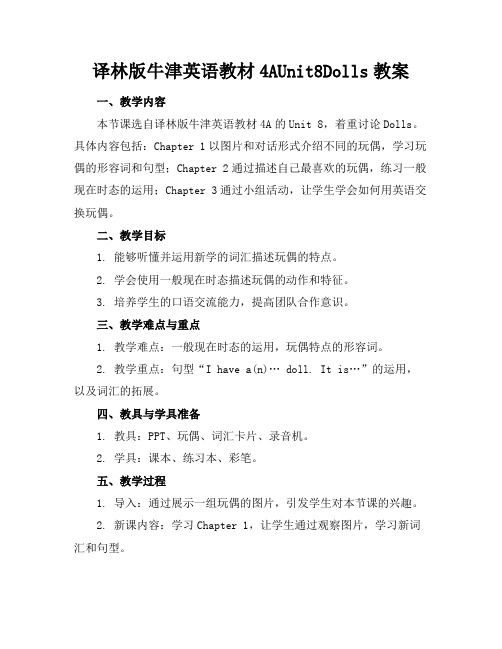
译林版牛津英语教材4AUnit8Dolls教案一、教学内容本节课选自译林版牛津英语教材4A的Unit 8,着重讨论Dolls。
具体内容包括:Chapter 1以图片和对话形式介绍不同的玩偶,学习玩偶的形容词和句型;Chapter 2通过描述自己最喜欢的玩偶,练习一般现在时态的运用;Chapter 3通过小组活动,让学生学会如何用英语交换玩偶。
二、教学目标1. 能够听懂并运用新学的词汇描述玩偶的特点。
2. 学会使用一般现在时态描述玩偶的动作和特征。
3. 培养学生的口语交流能力,提高团队合作意识。
三、教学难点与重点1. 教学难点:一般现在时态的运用,玩偶特点的形容词。
2. 教学重点:句型“I have a(n)… doll. It is…”的运用,以及词汇的拓展。
四、教具与学具准备1. 教具:PPT、玩偶、词汇卡片、录音机。
2. 学具:课本、练习本、彩笔。
五、教学过程1. 导入:通过展示一组玩偶的图片,引发学生对本节课的兴趣。
2. 新课内容:学习Chapter 1,让学生通过观察图片,学习新词汇和句型。
3. 实践情景引入:让学生带来自己的玩偶,用新学的词汇和句型进行描述。
4. 例题讲解:讲解一般现在时态的构成,通过例题让学生掌握该时态的应用。
5. 随堂练习:学生分组进行角色扮演,用所学句型和词汇进行交流。
6. 巩固环节:学习Chapter 2,让学生描述自己最喜欢的玩偶,进行口语练习。
7. 小组活动:学习Chapter 3,分组进行玩偶交换活动,练习口语表达。
六、板书设计1. Unit 8 Dolls2. 重点词汇和句型:形容词:beautiful, cute, lovely, big, small, tall, short句型:I have a(n)… doll. It is…七、作业设计1. 作业题目:请用英文描述你的玩偶,不少于5句话。
2. 答案示例:I have a beautiful doll. It is a girl doll.She has long hair and big eyes. She is wearing a red dress.My doll is very lovely. I like her very much.八、课后反思及拓展延伸1. 反思:关注学生在课堂上的参与度,及时调整教学方法,提高教学效果。
新概念第一册教案全册完整版

新概念第一册教案全册完整版一、教学内容1. Chapter 1: Excuse me!(对不起!)介绍日常用语,如问候、道歉、道别等。
基本语法:一般疑问句、否定句、一般现在时。
2. Chapter 2: Is this your?(这是你的吗?)学习如何描述物品和人物。
基本语法:一般现在时、一般疑问句、否定句。
3. Chapter 3: Thank you, madam.(谢谢,夫人。
)学习购物场景的日常用语。
基本语法:一般现在时、一般疑问句、否定句。
4. Chapter 4: What's the time?(现在几点?)学习时间表达法。
基本语法:一般现在时、一般疑问句、否定句。
5. Chapter 5: The Sawyer family.(索耶尔一家。
)学习家庭成员的称呼。
基本语法:一般现在时、一般疑问句、否定句。
二、教学目标1. 让学生掌握基本的日常英语用语,提高英语口语表达能力。
2. 使学生熟练运用一般现在时,形成正确的语法观念。
3. 培养学生用英语进行简单交流的能力。
三、教学难点与重点1. 教学难点:一般现在时、一般疑问句、否定句的运用。
2. 教学重点:日常英语用语的掌握。
四、教具与学具准备1. 教具:PPT、黑板、磁带、录音机。
2. 学具:教材、练习册、笔记本。
五、教学过程1. 导入:通过情景剧表演,让学生复习上一课的内容。
2. 新课内容:讲解本章重点单词、短语和句型。
3. 例题讲解:通过例题讲解,让学生理解语法点。
4. 随堂练习:让学生进行口头练习,巩固所学知识。
5. 小组活动:分组讨论,练习本章重点句型。
六、板书设计1. 重点单词、短语。
2. 重点句型。
七、作业设计1. 作业题目:(1)抄写本章重点单词、短语。
(2)用本章所学句型编写一段对话。
(3)完成练习册本章练习。
答案:见练习册答案。
八、课后反思及拓展延伸1. 反思:关注学生在课堂上的表现,及时发现问题,调整教学方法。
语言学选择题填空题判断题
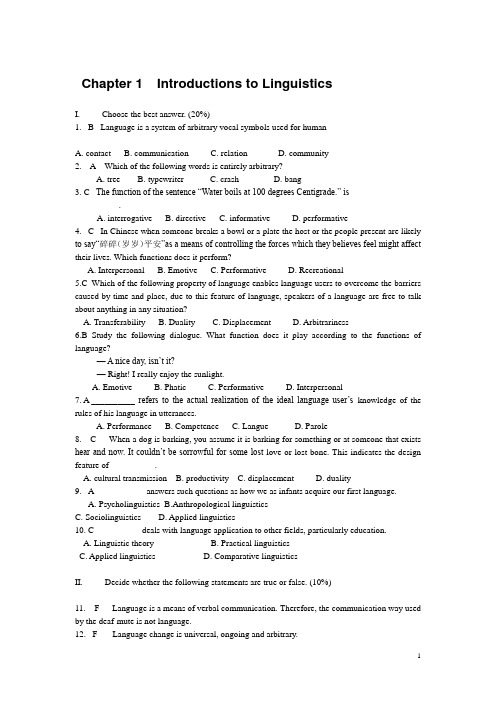
Chapter 1 Introductions to LinguisticsI. Choose the best answer. (20%)1. B Language is a system of arbitrary vocal symbols used for human__________A. contactB. communicationC. relationD. community2. A Which of the following words is entirely arbitrary?A. treeB. typewriterC. crashD. bang3. C The function of the sentence “Water boils at 100 degrees Centigrade.” is__________.A. interrogativeB. directiveC. informativeD. performative4. C In Chinese when someone breaks a bowl or a plate the host or the people present are likely to say“碎碎(岁岁)平安”as a means of controlling the forces which they believes feel might affect their lives. Which functions does it perform?A. InterpersonalB. EmotiveC. PerformativeD. Recreational5.C Which of the following property of language enables language users to overcome the barriers caused by time and place, due to this feature of language, speakers of a language are free to talk about anything in any situation?A. TransferabilityB. DualityC. DisplacementD. Arbitrariness6.B Study the following dialogue. What function does it play according to the functions of language?—A nice day, isn’t it?— Right! I really enjoy the sunlight.A. EmotiveB. PhaticC. PerformativeD. Interpersonal7. A __________ refers to the actual realization of the ideal language user’s knowledge of the rules of his language in utterances.A. PerformanceB. CompetenceC. LangueD. Parole8. C When a dog is barking, you assume it is barking for something or at someone that exists hear and now. It couldn’t be sorrowful for some lost love or lost bone. This indicates the design feature of __________.A. cultural transmissionB. productivityC. displacementD. duality9. A __________ answers such questions as how we as infants acquire our first language.A. PsycholinguisticsB.Anthropological linguisticsC. SociolinguisticsD. Applied linguistics10. C __________ deals with language application to other fields, particularly education.A. Linguistic theoryB. Practical linguisticsC. Applied linguisticsD. Comparative linguisticsII. Decide whether the following statements are true or false. (10%)11. F Language is a means of verbal communication. Therefore, the communication way used by the deaf-mute is not language.12. F Language change is universal, ongoing and arbitrary.13. T Speaking is the quickest and most efficient way of the human communication systems.14. F Language is written because writing is the primary medium for all languages.15. F We were all born with the ability to acquire language, which means the details of any language system can be genetically transmitted.16. F Only human beings are able to communicate.17. F F. de Saussure, who made the distinction between langue and parole in the early 20th century, was a French linguist.18. F A study of the features of the English used in Shakespeare’s time is an example of the diachronic study of language.19. F Speech and writing came into being at much the same time in human history.20. F All the languages in the world today have both spoken and written forms.III. Fill in the blanks. (10%)21. verbal Language, broadly speaking, is a means of __________ communication.22. productivity In any language words can be used in new ways to mean new things and can be combined into innumerable sentences based on limited rules. This feature is usually termed __________.23. metalingual function Language has many functions. We can use language to talk about itself. This function is __________.24. yo-he-ho Theory that primitive man made involuntary vocal noises while performing heavy work has been called the __________ theory.25. scientific Linguistics is the __________ study of language.26. descriptive Modern linguistics is __________ in the sense that the linguist tries to discover what language is rather than lay down some rules for people to observe.27. speech One general principle of linguistic analysis is the primacy of __________ over writing.28. diachronic linguistic The description of a language as it changes through time is a __________ study.29. langue Saussure put forward two important concepts. __________ refers to the abstract linguistic system shared by all members of a speech community.30. competence Linguistic potential is similar to Saussure’s langue and Chomsky’s __________.Chapter 2 Speech SoundsI. Choose the best answer. (20%)1. A Pitch variation is known as __________ when its patterns are imposed on sentences.A. intonationB. toneC. pronunciationD. voice2. C Conventionally a __________ is put in slashes (/ /).A. allophoneB. phoneC. phonemeD. morpheme3. D An aspirated p, an unaspirated p and an unreleased p are __________ of the p phoneme.A. analoguesB. tagmemesC. morphemesD. allophones4. A The opening between the vocal cords is sometimes referred to as__________.A. glottisB. vocal cavityC. pharynxD. uvula5. A The diphthongs that are made with a movement of the tongue towards the center are known as __________ diphthongs.A. wideB. closingC. narrowD. centering6. D A phoneme is a group of similar sounds called __________.A. minimal pairsB. allomorphsC. phonesD. allophones7. B Which branch of phonetics concerns the production of speech sounds?A. Acoustic phoneticsB. Articulatory phoneticsC. Auditory phoneticsD. None of the above8. A Which one is different from the others according to places of articulation?A. [n]B. [m]C. [ b ]D. [p]9. B Which vowel is different from the others according to the characteristics of vowels?A. [i:]B. [ u ]C. [e]D. [ i ]10. B What kind of sounds can we make when the vocal cords are vibrating?A. VoicelessB. V oicedC. Glottal stopD. ConsonantII. Decide whether the following statements are true or false. (10%)11. T Suprasegmental phonology refers to the study of phonological properties of units larger than the segment-phoneme, such as syllable, word and sentence.12. T The air stream provided by the lungs has to undergo a number of modification to acquire the quality of a speech sound.13. T Two sounds are in free variation when they occur in the same environment and do not contrast, namely, the substitution of one for the other does not produce a different word, but merely a different pronunciation.14. F [p] is a voiced bilabial stop.15. F Acoustic phonetics is concerned with the perception of speech sounds.16. T All syllables must have a nucleus but not all syllables contain an onset and a coda.17. T When pure vowels or monophthongs are pronounced, no vowel glides take place.18. T According to the length or tenseness of the pronunciation, vowels can be divided into tense vs. lax or long vs. short.19. F Received Pronunciation is the pronunciation accepted by most people.20. F The maximal onset principle states that when there is a choice as to where to place a consonant, it is put into the coda rather than the onset.III. Fill in the blanks. (20%)21. voiced, voiceless, voiced Consonant sounds can be either __________ or __________, while all vowel sounds are __________.22. friction Consonant sounds can also be made when two organs of speech in the mouth arebrought close together so that the air is pushed out between them, causing __________.23. tongue The qualities of vowels depend upon the position of the __________ and the lips.24. height One element in the description of vowels is the part of the tongue which is at the highest point in the mouth. A second element is the __________ to which that part of the tongue is raised.25. obstruction Consonants differ from vowels in that the latter are produced without __________.26. minimal pairs In phonological analysis the words fail / veil are distinguishable simply because of the two phonemes /f/ - /v/. This is an example for illustrating __________.27. diphthongs In English there are a number of __________, which are produced by moving from one vowel position to another through intervening positions.28. Co-articulation __________ refers to the phenomenon of sounds continually show the influence of their neighbors.29. Phonemes __________ is the smallest linguistic unit.30. air stream Speech takes place when the organs of speech move to produce patterns of sound. These movements have an effect on the __________ coming from the lungs.Chapter 3 LexiconI. Choose the best answer. (20%)1. A Nouns, verbs and adjectives can be classified as __________.A. lexical wordsB. grammatical wordsC. function wordsD. form words2. A Morphemes that represent tense, number, gender and case are called __________ morpheme.A. inflectionalB. freeC. boundD. derivational3. C There are __________ morphemes in the word denationalization.A. threeB. fourC. fiveD. six4. B In English –ise and –tion are called __________.A. prefixesB. suffixesC. infixesD. stems5. B The three subtypes of affixes are: prefix, suffix and __________.A. derivational affixB. inflectional affixC. infixD. back-formation6. B __________ is a way in which new words may be formed from already existing words by subtracting an affix which is thought to be part of the old word.A. affixationB. back-formationC. insertionD. addition7. C The word TB is formed in the way of __________.A. acronymyB. clippingC. initialismD. blending8. A The words like comsat and sitcom are formed by __________.A. blendingB. clippingC. back-formationD. acronymy9. D The stem of disagreements is __________.A. agreementB. agreeC. disagreeD. disagreement10. B All of them are meaningful except for __________.A. lexemeB. phonemeC. morphemeD. allomorphII. Decide whether the following statements are true or false. (10%)11. F Phonetically, the stress of a compound always falls on the first element, while the second element receives secondary stress.12. T Fore as in foretell is both a prefix and a bound morpheme.13. F Base refers to the part of the word that remains when all inflectional affixes are removed.14. T In most cases, prefixes change the meaning of the base whereas suffixes change the word-class of the base.15. T Conversion from noun to verb is the most productive process of a word.16. F Reduplicative compound is formed by repeating the same morpheme of a word.17. T The words whimper, whisper and whistle are formed in the way of onomatopoeia.18. F In most cases, the number of syllables of a word corresponds to the number of morphemes.19. F Back-formation is a productive way of word-formations.20. F Inflection is a particular way of word-formations.III. Fill in the blanks. (20%)21. initialism, acronym An __________ is pronounced letter by letter, while an __________ is pronounced as a word.22. vocabulary Lexicon, in most cases, is synonymous with __________.23. solid, hyphenated, open Orthographically, compounds are written in three ways: __________, __________ and __________.24. morpheme All words may be said to contain a root __________.25. close, open A small set of conjunctions, prepositions and pronouns belong to __________ class, while the largest part of nouns, verbs, adjectives and adverbs belongs to __________ class.26. back-formation __________ is a reverse process of derivation, and therefore is a process of shortening.27. conversion __________ is extremely productive, because English had lost most of its inflectional endings by the end of Middle English period, which facilitated the use of words interchangeably as verbs or nouns, verbs or adjectives, and vice versa.28. morpheme Words are divided into simple, compound and derived words on the __________ level.29. derivative, compound A word formed by derivation is called a __________, and a word formed by compounding is called a __________.30. affix, bound root Bound morphemes are classified into two types: __________ and __________.Chapter 4 SyntaxI. Choose the best answer. (20%)1. D The sentence structure is ________.A. only linearB. only hierarchicalC. complexD. both linear and hierarchical2. C The syntactic rules of any language are ____ in number.A. largeB. smallC. finiteD. infinite3. D The ________ rules are the rules that group words and phrases to form grammatical sentences.A. lexicalB. morphologicalC. linguisticD. combinational4. D A sentence is considered ____ when it does not conform to the grammati¬cal knowledge in the mind of native speakers.A. rightB. wrongC. grammaticalD. ungrammatical5. D A __________ in the embedded clause refers to the introductory word that introduces the embedded clause.A. coordinatorB. particleC. prepositionD. subordinator6. A Phrase structure rules have ____ properties.A. recursiveB. grammaticalC. socialD. functional7. D Phrase structure rules allow us to better understand _____________.A. how words and phrases form sentences.B. what constitutes the grammaticality of strings of wordsC. how people produce and recognize possible sentencesD. all of the above.8. D The head of the phrase “the city Rome” is __________.A. the cityB. RomeC. cityD. the city Rome9. B The phrase “on the shelf” belongs to __________ construction.A. endocentricB. exocentricC. subordinateD. coordinate10. A The sentence “They were wanted to remain quiet and not to expose themselves.” is a __________ sentence.A. simpleB. coordinateC. compoundD. complexII. Decide whether the following statements are true or false. (10%)11. T Universally found in the grammars of all human languages, syntactic rules that comprise the system of internalized linguistic knowledge of a language speaker are known as linguistic competence.12. T The syntactic rules of any language are finite in number, but there is no limit to the number of sentences native speakers of that language are able to produce and comprehend.13. T In a complex sentence, the two clauses hold unequal status, one subordinating the other.14. T Constituents that can be substituted for one another without loss of grammaticality belong to the same syntactic category.15. F Minor lexical categories are open because these categories are not fixed and new members are allowed for.16. F In English syntactic analysis, four phrasal categories are commonly recognized and discussed, namely, noun phrase, verb phrase, infinitive phrase, and auxiliary phrase.17. T In English the subject usually precedes the verb and the direct object usually follows the verb.18. F What is actually internalized in the mind of a native speaker is a complete list of words and phrases rather than grammatical knowledge.19. T A noun phrase must contain a noun, but other elements are optional.20. T It is believed that phrase structure rules, with the insertion of the lexicon, generate sentences at the level of D-structure.III. Fill in the blanks. (20%)21. simple A __________ sentence consists of a single clause which contains a subject and a predicate and stands alone as its own sentence.22. sentence A __________ is a structurally independent unit that usually comprises a number of words to form a complete statement, question or command.23. subject A __________ may be a noun or a noun phrase in a sentence that usually precedes the predicate.24. predicate The part of a sentence which comprises a finite verb or a verb phrase and which says something about the subject is grammatically called __________.25. complex A __________ sentence contains two, or more, clauses, one of which is incorporated into the other.26. embedded In the complex sentence, the incorporated or subordinate clause is normally called an __________ clause.27. open Major lexical categories are __________ categories in the sense that new words are constantly added.28. Adjacency __________ condition on case assignment states that a case assignor and a case recipient should stay adjacent to each other.29. Parameters __________ are syntactic options of UG that allow general principles to operate in one way or another and contribute to significant linguistic variations between and among natural languages.30. CASE The theory of __________ condition explains the fact that noun phrases appear only in subject and object positions.Chapter 5 Meaning[Mainly taken from lxm1000w’s exercises. – icywarmtea]I. Choose the best answer. (20%)1. A The naming theory is advanced by ________.A. PlatoB. BloomfieldC. Geoffrey LeechD. Firth2. B “We shall know a word by the company it keeps.” This statement represents _______.A. the conceptualist viewB. contexutalismC. the naming theoryD. behaviorism3. D Which of the following is NOT true?A. Sense is concerned with the inherent meaning of the linguistic form.B. Sense is the collection of all the features of the linguistic form.C. Sense is abstract and decontextualized.D. Sense is the aspect of meaning dictionary compilers are not interested in.4. D “Can I borrow your bike?”_______ “You have a bike.”A. is synonymous withB. is inconsistent withC. entailsD. presupposes5. B ___________ is a way in which the meaning of a word can be dissected into meaning components, called semantic features.A. Predication analysisB. Componential analysisC. Phonemic analysisD. Grammatical analysis6. C “Alive” and “dead” are ______________.A. gradable antonymsB. relational antonymsC. complementary antonymsD. None of the above7. A _________ deals with the relationship between the linguistic element and the non-linguistic world of experience.A. ReferenceB. ConceptC. SemanticsD. Sense8. C ___________ refers to the phenomenon that words having different meanings have the same form.A. PolysemyB. SynonymyC. HomonymyD. Hyponymy9. D Words that are close in meaning are called ______________.A. homonymsB. polysemiesC. hyponymsD. synonyms10. A The grammaticality of a sentence is governed by _______.A. grammatical rulesB. selectional restrictionsC. semantic rulesD. semantic featuresII. Decide whether the following statements are true or false. (10%)11. F Dialectal synonyms can often be found in different regional dialects such as British English and American English but cannot be found within the variety itself, for example, within British English or American English.12. F Sense is concerned with the relationship between the linguistic element and the non-linguistic world of experience, while the reference deals with the inherent meaning of the linguistic form.13. T Linguistic forms having the same sense may have different references in different situations.14. F In semantics, meaning of language is considered as the intrinsic and inherent relation to the physical world of experience.15. T Contextualism is based on the presumption that one can derive meaning from or reduce meaning to observable contexts.16. T Behaviorists attempted to define the meaning of a language form as the situation in which the speaker utters it and the response it calls forth in the hearer.17. F The meaning of a sentence is the sum total of the meanings of all its components.18. T Most languages have sets of lexical items similar in meaning but ranked differently according to their degree of formality.19. T “It is hot.” is a no-place predication because it contains no argument.20. T In grammatical analysis, the sentence is taken to be the basic unit, but in semantic analysis of a sentence, the basic unit is predication, which is the abstraction of the meaning of a sentence.III. Fill in the blanks. (20%)21. Semantics __________ can be defined as the study of meaning.22. direct The conceptualist view holds that there is no __________ link between a linguistic form and what it refers to.23. Reference __________ means what a linguistic form refers to in the real, physical world; it deals with the relationship between the linguistic element and the non-linguistic world of experience.24. synonyms Words that are close in meaning are called __________.25. homophones When two words are identical in sound, but different in spelling and meaning, they are called __________.26.Relational __________ opposites are pairs of words that exhibit the reversal of a relationship between the two items.27. Componential __________ analysis is based upon the belief that the meaning of a word can be divided into meaning components.28. selectional Whether a sentence is semantically meaningful is governed by rules called __________ restrictions, which are constraints on what lexical items can go with what others. 29. argument A(n) __________ is a logical participant in a predication, largely identical with the nominal element(s) in a sentence.30. naming According to the __________ theory of meaning, the words in a lan¬guage are taken to be labels of the objects they stand for.Chapter 8 Language in UseI. Choose the best answer. (20%)1. D What essentially distinguishes semantics and pragmatics is whether in the study of meaning _________ is considered.A. referenceB. speech actC. practical usageD. context2. B A sentence is a _________ concept, and the meaning of a sentence is often studied in isolation.A. pragmaticB. grammaticalC. mentalD. conceptual3. C If we think of a sentence as what people actually utter in the course of communication, it becomes a (n) _________.A. constativeB. directiveC. utteranceD. expressive4. B Which of the following is true?A. Utterances usually do not take the form of sentences.B. Some utterances cannot be restored to complete sentences.C. No utterances can take the form of sentences.D. All utterances can be restored to complete sentences.5. A Speech act theory did not come into being until __________.A. in the late 50’s of the 20the centuryB. in the early 1950’sC. in the late 1960’sD. in the early 21st century6. C __________ is the act performed by or resulting from saying something; it is the consequence of, or the change brought about by the utterance.A. A locutionary actB. An illocutionary actC. A perlocutionary actD. A performative act7. B According to Searle, the illocutionary point of the representative is ______.A. to get the hearer to do somethingB. to commit the speaker to something’s being the caseC. to commit the speaker to some future course of actionD. to express the feelings or attitude towards an existing state of affairs8. C All the acts that belong to the same category share the same purpose, but they differ __________.A. in their illocutionary actsB. in their intentions expressedC. in their strength or forceD. in their effect brought about9. A __________ is advanced by Paul GriceA. Cooperative PrincipleB. Politeness PrincipleC. The General Principle of Universal GrammarD. Adjacency Principle10.D When any of the maxims under the cooperative principle is flouted, _______ might arise.A. impolitenessB. contradictionsC. mutual understandingD. conversational implicaturesII. Decide whether the following statements are true or false. (10%)11. F Pragmatics treats the meaning of language as something intrinsic and inherent.12. T It would be impossible to give an adequate description of meaning if the context of language use was left unconsidered.13. T What essentially distinguishes semantics and pragmatics is whether in the study of meaning the context of use is considered.14. F The major difference between a sentence and an utterance is that a sentence is not uttered while an utterance is.15. F The meaning of a sentence is abstract, but context-dependent.16. F The meaning of an utterance is decontexualized, therefore stable.17. F Utterances always take the form of complete sentences18. F Speech act theory was originated with the British philosopher John Searle.19. T Speech act theory started in the late 50’s of the 20th century.20. T Austin made the distinction between a constative and a performative.III. Fill in the blanks. (20%)21. context The notion of __________ is essential to the pragmatic study of language.22. utterance If we think of a sentence as what people actually utter in the course of communication, it becomes an __________.23. abstract The meaning of a sentence is __________, and decontexualized.24. Constatives were statements that either state or describe, and were thus verifiable.25. Performatives were sentences that did not state a fact or describe a state, and were not verifiable.26. locutionary A(n) __________ act is the act of uttering words, phrases, clauses. It is the act of conveying literal meaning by means of syntax, lexicon and phonology.27. illocutionary A(n) __________ act is the act of expressing the speaker’s intention; it is the act performed in saying something.28. commissive A(n) _________ is commit the speaker himself to some future course of action.29. expressive A(n) ________ is to express feelings or attitude towards an existing state.30. quantity There are four maxims under the cooperative principle: the maxim of __________, the maxim of quality, the maxim of relation and the maxim of manner.11。
2024年新职业英语2通用版Unit4教育课件
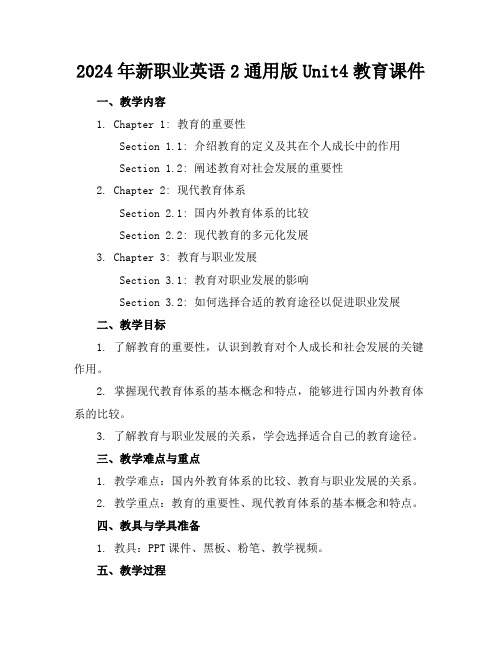
2024年新职业英语2通用版Unit4教育课件一、教学内容1. Chapter 1: 教育的重要性Section 1.1: 介绍教育的定义及其在个人成长中的作用Section 1.2: 阐述教育对社会发展的重要性2. Chapter 2: 现代教育体系Section 2.1: 国内外教育体系的比较Section 2.2: 现代教育的多元化发展3. Chapter 3: 教育与职业发展Section 3.1: 教育对职业发展的影响Section 3.2: 如何选择合适的教育途径以促进职业发展二、教学目标1. 了解教育的重要性,认识到教育对个人成长和社会发展的关键作用。
2. 掌握现代教育体系的基本概念和特点,能够进行国内外教育体系的比较。
3. 了解教育与职业发展的关系,学会选择适合自己的教育途径。
三、教学难点与重点1. 教学难点:国内外教育体系的比较、教育与职业发展的关系。
2. 教学重点:教育的重要性、现代教育体系的基本概念和特点。
四、教具与学具准备1. 教具:PPT课件、黑板、粉笔、教学视频。
五、教学过程1. 导入:通过展示一组关于教育对个人成长和社会发展的图片,引发学生对教育重要性的思考。
2. 新课内容讲解:Chapter 1:介绍教育的定义,分析教育在个人成长和社会发展中的作用。
Chapter 2:比较国内外教育体系,阐述现代教育的多元化发展。
Chapter 3:讲解教育与职业发展的关系,指导学生如何选择合适的教育途径。
3. 例题讲解:针对每个章节的重点内容,设计相关例题,进行详细讲解。
4. 随堂练习:让学生针对每个章节的知识点进行随堂练习,巩固所学内容。
六、板书设计1. 板书2024年新职业英语2通用版Unit 4 教育课件2. 板书内容:Chapter 1: 教育的重要性Chapter 2: 现代教育体系Chapter 3: 教育与职业发展七、作业设计1. 作业题目:根据所学内容,谈谈你对教育重要性的认识。
高效课堂教学流程及课堂常规

教师根据学生的课堂表现、作业完成情况、考试 成绩等进行评价,为学生提供有针对性的指导和 建议。
教师评价
课堂观察
教师在课堂上密切关注学生的表现,包括注意力、参与度、思维 活跃度等,以便及时调整教学策略。
作业批改
教师认真批改学生的作业,指出存在的问题和不足,同时给予积 极的鼓励和肯定。
考试评估
02
模拟真实情境,让学生在模拟环境中进行实践操作,增强实际
应用能力。
总结反思
03
引导学生对所学知识进行总结反思,发现不足之处,进一步提
高实践能力。
04 课堂评价与反馈
CHAPTER
学生评价
1 2 3
学生自评
学生自我评价在学习过程中的表现和进步,有助 于培养自我意识和自主学习的能力。
学生互评
同学之间的相互评价可以促进彼此之间的交流和 学习,同时也能让学生从不同的角度认识自己的 优点和不足。
或违反安全规定的行为。
03 高效课堂的教学策略
CHAPTER
激发学生兴趣
创设情境
利用多媒体、实物展示等手段,创设生动有趣的 学习情境,吸引学生的注意力。
联系生活
将教学内容与学生的实际生活联系起来,引导学 生从生活中发现知识,提高学习兴趣。
鼓励尝试
鼓励学生大胆尝试,让学生在实践中体验学习的 乐趣,激发学习动力。
优化教学环境
营造良好的课堂氛围
教师应积极营造民主、平等、和谐的课堂氛围,鼓励学生 积极参与课堂活动,激发学生的学习热情和创造力。
提供丰富的教学资源
学校应提供多样化的教学资源,如图书、多媒体、实验器 材等,以满足学生的学习需求,提高教学效果。
创造良好的学习环境
说课听课评课技能讲解课件

说课、听课、评课三者相互关联,相互促进,共同构成了一 个完整的教学研究过程。
说课、听课、评课在实践教学中的应用
在实践教学活动中,说课可以帮 助教师明确教学目标和教学内容 ,提高教学设计的科学性和有效
通过案例分析,教师可以了解不同教 学方法和策略的优缺点,学习如何根 据不同的教学内容和教学目标选择合 适的教学方法,提高教学效果。
谢谢
THANKS
教学评价是否及时、准 确,是否能够促进学生 的学习进步和教师教学
水3
观察课堂
评课者需要仔细观察课堂 ,注意教师的教学行为、 学生的学习状态以及课堂 氛围等方面的情况。
分析问题
评课者需要深入分析教学 中存在的问题,并提出建 设性的改进意见和建议。
沟通交流
评课者需要与授课教师进 行积极有效的沟通交流, 共同探讨教学改进的方法 和途径。
性。
听课可以帮助教师了解其他教师 的教学风格和教学方法,学习他 人的优点和经验,提高自己的教
学水平。
评课可以帮助教师对其他教师的 教学过程进行反思和评价,提出 改进意见和建议,促进教学质量
的提高。
说课、听课、评课的综合案例分析
综合案例分析可以帮助教师更好地理 解和掌握说课、听课、评课的方法和 技巧,提高教师的实践能力和教学水 平。
评课案例分析
案例选择
选择具有代表性的教学案 例,进行深入细致的分析 和评价。
案例分析
从教学目标、教学内容、 教学方法、教学评价等方 面对案例进行分析,指出 其优点和不足之处。
案例总结
总结案例中值得借鉴的经 验和教训,提出对教学实 践的启示和建议。
教师资格证数学学科知识与教学能力(高中数学)
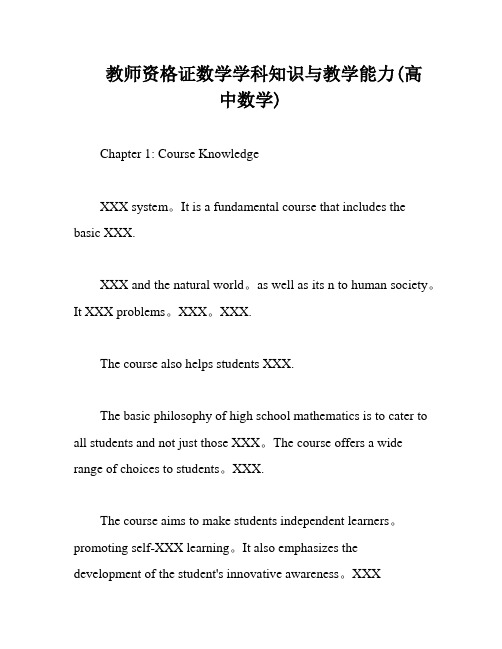
教师资格证数学学科知识与教学能力(高中数学)Chapter 1: Course KnowledgeXXX system。
It is a fundamental course that includes the basic XXX.XXX and the natural world。
as well as its n to human society。
It XXX problems。
XXX。
XXX.The course also helps students XXX.The basic philosophy of high school mathematics is to cater to all students and not just those XXX。
The course offers a wide range of choices to students。
XXX.The course aims to make students independent learners。
promoting self-XXX learning。
It also emphasizes the development of the student's innovative awareness。
XXXThe course XXX basic skills of mathematics。
knowledge。
and ability。
It emphasizes the XXX。
their essence。
and the XXX.Mathematics is an essential part of human culture。
and the course highlights its cultural significance。
The course emphasizes the importance of evaluating student progress and learning es。
2024年译林版4Aunit8Dolls教案

2024年译林版4Aunit8Dolls教案一、教学内容本节课选自2024年译林版4A教材,第八单元Dolls。
主要内容包括:教材Chapter 8的1a1d部分,学习关于doll的词汇,以及如何描述doll的特征。
二、教学目标1. 能够听懂、会说、会读、会写关于doll的词汇,如:pretty, lovely, big, small等。
2. 能够用所学词汇描述doll的特征,进行简单的交流。
3. 培养学生的观察能力和表达能力,激发他们对英语学习的兴趣。
三、教学难点与重点重点:关于doll的词汇和描述特征的表达。
难点:如何灵活运用所学词汇和句型进行交流。
四、教具与学具准备1. 教具:PPT、图片、录音机、磁带等。
2. 学具:单词卡片、练习册、彩色笔等。
五、教学过程1. 导入:展示各种漂亮的doll图片,引导学生用中文描述它们的特点,进而引出本节课主题。
2. 新课展示:学习1a1d部分,通过PPT展示、录音机播放,让学生听、说、读、写关于doll的词汇和句型。
3. 实践情景引入:邀请几位同学到讲台上,用所学词汇和句型描述他们手中的doll,其他同学认真听,并尝试回答问题。
4. 例题讲解:选取教材中的典型例题,讲解解题思路和步骤。
5. 随堂练习:让学生两人一组,互相描述手中的doll,并进行角色扮演。
六、板书设计1. Dolls2. 主要词汇:pretty, lovely, big, small等3. 句型:What's the doll like? It's4. 例题及答案七、作业设计1. 作业题目:描述你最喜欢的doll,不少于5句话。
答案示例:My favorite doll is very pretty. It has big eyes and a small mouth. Its hair is long and blonde. I like it very much because it's very cute.2. 作业要求:用所学词汇和句型进行描述,注意语法和书写规范。
【学习实践】Chapter 8 Two geniuses教案

Chapter 8 Two geniuses教案chapter8TwogeniusesReadingIILanguagePoints[教材版本oxfordEnglish(ShenzhenEdition)[课题名称]:chapter8ReadingIILanguagepoints[授课课时]:第二课时(共三课时)[教材分析]:(一)课文内容:本课的标题是Twogeniuses,围绕天才爱因斯坦和他的司机汉斯的一段轶事,组织学生开展语言知识点学习的一系列活动。
学生已于前一课时对课文内容有了较全面的理解,也跟读了新单词,为本课时的学习奠定了基础。
(二)课前准备:要求学生了解爱因斯坦的更多事迹和喜欢的天才的事迹,为语言知识点的导入和运用做好背景知识准备;跟读了新单词。
[教学目标]:1.语言知识目标:学生在具体情境中学习本课的语言知识点并懂得如何运用它们;.2.语言功能目标:提高学生在相关情景中运用语言知识点的能力。
3.情感教育目标:思考天才是如何炼成的,形成正确的价值观--“天才始于勤奋和个人终生的刻苦奋斗”。
[教学重难点]:教学重点:掌握本课的重点单词、短语和句型:单词(2):genius,perfectly;短语(8):regard…as,anattempttodo,agift/talentforsth.,asenseofhumour ,givealecture,learn…byheart,letsb.down,offertodosth.;句型(1):It’sapleasuretodosth.教学难点:创设情境,设计活动,让学生在活动中通过所学语言知识点的运用来熟悉掌握知识点。
[教学方式]:任务型教学,小组合作活动、小组竞赛。
[教学用具]:多媒体平台,PPT。
[教学过程]:教学过程设计意图一、Leadin:Brain-storming:Teacher:yesterday,welearnastoryaboutagreatgenius.whoishe?St udents:AlbertEinstein.T:Now,Iwillshowyousomepicture sofanotherthreegeniusesandthenyoutellmeanythingyoua boutthem.clear?Ss:yesTeacher:whoishe?whatdoyouknowabouthim?Students:Lang Lang,apianist,goodatplayingpiano,apianoprodigy,stun ning,oneoftheyoungestandgreatestpianistofourtime.….通过展示学生熟悉的当代天才(朗朗、比尔盖茨和迈克尔乔丹),让学生通过头脑风暴来谈论对他们的了解,顺利引入本课的话题,为课堂奠定良好气氛和基础二、PresentingthelanguagepointsLanguagepoints:genius,regard…as,anattempttodo,agift/talentforsth.,asenseofhumour ,givealecture,perfectly,letsb.down,learn…byheart,offertodo,It’sapleasuretodo.E.g.:givealectureT:Lookatthepicture, whatwasEinsteindoing?Ss:Hewasgivingalectureonthepla tform.T:welldone.Here,lecturemeans讲座,sogivealecturemeans做一次讲座/演讲。
2024年完整版译林版七年级上册英语教案【】

2024年完整版译林版七年级上册英语教案【】一、教学内容本节课选自2024年完整版译林版七年级上册英语教材,具体包括Unit 1 This is me! 的Chapter 1和Chapter 2。
主要内容包括:介绍自己、问候他人、描述外貌、谈论兴趣爱好等。
二、教学目标1. 学生能够熟练运用本节课所学的词汇和句型,介绍自己、问候他人。
2. 学生能够理解并运用一般现在时描述自己的外貌和兴趣爱好。
3. 培养学生的听说能力和口语表达能力,增强他们的自信心。
三、教学难点与重点重点:一般现在时、介绍自己、问候他人、描述外貌和兴趣爱好。
难点:一般现在时的运用、外貌和兴趣爱好词汇的掌握。
四、教具与学具准备教师准备:PPT、教学卡片、录音机、磁带。
学生准备:课本、练习本、彩色笔。
五、教学过程1. 导入:教师播放一段关于自我介绍的短片,引导学生关注短片中的关键信息,为新课内容做铺垫。
(1)教师提问:“What do you know about the video?”(2)学生回答:“The video is about introducing oneself.”2. 呈现:教师通过PPT展示本节课的主要词汇和句型,带领学生朗读和模仿。
(1)教师展示词汇卡片,引导学生跟读。
(2)教师展示句型卡片,引导学生进行角色扮演。
3. 实践:学生两人一组,运用所学的词汇和句型进行自我介绍和问候。
(1)教师给出提示,学生进行对话练习。
(2)教师邀请几组学生上台展示。
(1)教师提问:“Do you like reading books?”(2)学生回答:“Yes, I do. / No, I don't.”5. 巩固:教师布置随堂练习,检查学生对本节课内容的掌握。
(1)完成练习册上的相关习题。
(2)教师批改并反馈。
六、板书设计1. 主要词汇:name, age, school, hob, like, love, do, play, read, write, listen, speak2. 主要句型:Hello, my name is; I amyears old; I go toschool; I like/love3. 一般现在时:主语+动词原形/第三人称单数七、作业设计1. 作业题目:(1)用一般现在时介绍自己的家庭成员,至少写5句话。
2024年新外研版三起五年级英语上册教案

2024年新外研版三起五年级英语上册教案一、教学内容本节课选自2024年新外研版三起五年级英语上册,内容包括Unit 1 “My New Teachers”的Chapter 1和Chapter 2。
详细内容如下:1. Chapter 1:介绍新学期的老师们,包括他们的外貌、性格、爱好等。
2. Chapter 2:学习描述老师的特点,用一般现在时表达。
二、教学目标1. 能够听懂、会说、会读、会写关于老师特点的词汇和句子。
2. 能够运用一般现在时描述老师的特点。
3. 培养学生尊敬老师、热爱学校的情感。
三、教学难点与重点1. 教学难点:一般现在时的运用,描述老师特点的词汇和句型。
2. 教学重点:学会描述老师的特点,用一般现在时表达。
四、教具与学具准备1. 教具:PPT、卡片、录音机、磁带。
2. 学具:课本、练习本、彩笔。
五、教学过程1. 导入:通过PPT展示学校的图片,引导学生谈论自己的老师,激发学习兴趣。
2. 新课内容呈现:a. 听录音,学生跟读,学习新单词和句子。
b. 老师讲解一般现在时的用法,并举例说明。
c. 学生进行角色扮演,练习描述老师的特点。
3. 例题讲解:讲解关于老师特点的例题,引导学生运用一般现在时描述。
4. 随堂练习:学生完成练习册上的题目,巩固所学知识。
5. 小组活动:学生分组讨论,用一般现在时描述彼此的老师。
六、板书设计1. My New Teachers2. 内容:a. 新单词:tall, short, kind, strict, funny, smartb. 句型:He/She is; He/She hasc. 一般现在时:主语 + be动词(am/is/are) + 形容词七、作业设计1. 作业题目:a. 用一般现在时描述你的老师,不少于5句话。
b. 画出你心目中的理想老师,并用英文标注特点。
答案示例:My teacher is tall and kind. She has long hair and wears glasses. She is very patient and always helps us when we have problems. She likes reading books and playing sports. I like her very much.八、课后反思及拓展延伸2. 拓展延伸:鼓励学生课下了解更多关于老师的信息,如教育背景、教学理念等,提高学生的英语实际运用能力。
胡壮麟《语言学教程》(修订版)测试题——第八章:语言的使用

Chapter 8 Language in UseI. Choose the best answer. (20%)1. What essentially distinguishes semantics and pragmatics is whether in the study of meaning _________ is considered.A. referenceB. speech actC. practical usageD. context2. A sentence is a _________ concept, and the meaning of a sentence is often studied in isolation.A. pragmaticB. grammaticalC. mentalD. conceptual3. If we think of a sentence as what people actually utter in the course of communication, it becomes a (n) _________.A. constativeB. directiveC. utteranceD. expressive4. Which of the following is true?A. Utterances usually do not take the form of sentences.B. Some utterances cannot be restored to complete sentences.C. No utterances can take the form of sentences.D. All utterances can be restored to complete sentences.5. Speech act theory did not come into being until __________.A. in the late 50’s of the 20the centuryB. in the early 1950’sC. in the late 1960’sD. in the early 21st century6. __________ is the act performed by or resulting from saying something; it is the consequence of, or the change brought about by the utterance.A. A locutionary actB. An illocutionary actC. A perlocutionary actD. A performative act7. According to Searle, the illocutionary point of the representative is ______.A. to get the hearer to do somethingB. to commit the speaker to something’s being the caseC. to commit the speaker to some future course of actionD. to express the feelings or attitude towards an existing state of affairs8. All the acts that belong to the same category share the same purpose, but they differ __________.A. in their illocutionary actsB. in their intentions expressedC. in their strength or forceD. in their effect brought about9. __________ is advanced by Paul GriceA. Cooperative PrincipleB. Politeness PrincipleC. The General Principle of Universal GrammarD. Adjacency Principle10. When any of the maxims under the cooperative principle is flouted, _______ might arise.A. impolitenessB. contradictionsC. mutual understandingD. conversational implicaturesII. Decide whether the following statements are true or false. (10%)11. Pragmatics treats the meaning of language as something intrinsic and inherent.12. It would be impossible to give an adequate description of meaning if the context oflanguage use was left unconsidered.13. What essentially distinguishes semantics and pragmatics is whether in the study of meaning the context of use is considered.14. The major difference between a sentence and an utterance is that a sentence is not uttered while an utterance is.15. The meaning of a sentence is abstract, but context-dependent.16. The meaning of an utterance is decontexualized, therefore stable.17. Utterances always take the form of complete sentences18. Speech act theory was originated with the British philosopher John Searle.19. Speech act theory started in the late 50’s of the 20th century.20. Austin made the distinction between a constative and a performative.III. Fill in the blanks. (20%)21. The notion of __________ is essential to the pragmatic study of language.22. If we think of a sentence as what people actually utter in the course of communication, it becomes an __________.23. The meaning of a sentence is __________, and decontexualized.24. __________ were statements that either state or describe, and were thus verifiable.25. __________ were sentences that did not state a fact or describe a state, and were not verifiable.26. A(n) __________ act is the act of uttering words, phrases, clauses. It is the act of conveying literal meaning by means of syntax, lexicon and phonology.27. A(n) __________ act is the act of expressing the speaker’s intention; it is the act performed in saying something.28. A(n) _________ is commit the speaker himself to some future course of action.29. A(n) ________ is to express feelings or attitude towards an existing state.30. There are four maxims under the cooperative principle: the maxim of __________, the maxim of quality, the maxim of relation and the maxim of manner.IV. Explain the following terms, using examples. (20%)31. Conversational implicature32. Performative33. Locutionary act34. Q-principle (Horn)V. Answer the following questions. (20%)35. Explain the following remarks with examples or make some comments.“Both semantics and pragmatics are concerned with meaning, but the difference between them can be traced to two different uses of the verb mean: (a) What does X mean? (b) What did you mean by X?”(东北师范大学,2006)36. Do you think B is cooperative in the following dialogue? Support your argument with Cooperative Principle. (南开大学,2004)A: When is the bus coming?B: There has been an accident further up the road.VI. Analyze the following situation. (20%)37. What is the function of context in communication? Try to explain the following utterances rather than just state facts.(1) The room is messy.(2) It would be good if she had a green skirt on.Key:I.1~5 DBCBA 6~10 CBCADII.11~15 FTTFF 16~20 FFFTTIII.21. context 22. utterance23. abstract 24. Constatives25. Performatives 26. locutionary27. illocutionary 28. commissive29. expressive 30. quantityIV.31. Conversational implicature: In our daily life, speakers and listeners involved in conversation are generally cooperating with each other. In other words, when people are talking with each other, they must try to converse smoothly and successfully. In accepting speakers’ presuppositions, listeners have to assume that a speaker is not trying to mislead them. This sense of cooperation is simply one in which people having a conversation are not normally assumed to be trying to confuse, trick, or withhold relevant information from one another. However, in real communication, the intention of the speaker is often not the literal meaning of what he or she says. The real intention implied in the words is called conversational implicature.32. Performative: In speech act theory an utterance which performs an act, such as Watch out (= a warning).33. Locutionary act: A locutionary act is the saying of something which is meaningful and can be understood.34. Horn’s Q-principle: (1) Make your contribution sufficient (cf. quantity); (2) Say as much as you can (given R).V.35.Pragmatics is the study of the use of language in communication, particularly the relationships between sentences and the contexts and situations in which they are used. Pragmatics includes the study of(1) How the interpretation and use of utterances depends on knowledge of the real world;(2) How speakers use and understand speech acts;(3) How the structure of sentences is influenced by the relationship between the speaker and the hearer.Pragmatics is sometimes contrasted with semantics, which deals with meaning without reference to the users and communicative functions of sentences.36.Yes, B is cooperative. On the face of it, B’s statement is not an answer to A’s question. B doesn’t say “when.” However, A will immediately interpret the statement as meaning “I don’t know” or “I am not sure.” Just assume that B is being “relevant” and “informative.” Given that B’s answer contains relevant information, A can work out that “an accident further up the road”conventionally involves “traffic jam,” and “traffic jam” preludes “bus coming.” Thus, B’s answer is not simply a statement of “when the bus comes”; it contains an implicature concerning “when the bus comes.”VI.37.It occurs before and / or after a word, a phrase or even a longer utterance or a text. The context often helps in understanding the particular meaning of the word, phrase, etc.The context may also be the broader social situation in which a linguistic item is used.(1)a. A mild criticism of someone who should have cleaned the room.b. In a language class where a student made a mistake, for he intended to say “tidy.”c. The room was wanted for a meeting.(2)a. A mild way to express disagreement with someone who has complimented on a lady’s appearance.b. A regret that the customer had not taken the dress.c. That she wore a red shirt was not in agreement with the custom on the occasion.。
课堂教学中课件的角色与位置

优化课件设计
与传统教学方法相结合
加强技术培训
教师应注重课件的设计,合理安排信息量,增加互动性,提高学生的学习效果。
教师应将传统教学方法与课件相结合,发挥各自的优势,提高教学效果。
学校应加强教师技术培训,提高教师的课件制作和使用能力,解决技术障碍问题。
04
CHAPTER
课件与传统教学的关系
课件制作与使用建议
内容准确
简洁明了
设计美观
互动性强
01
02
03
04
确保课件内容准确无误,与教材和课程要求相一致。
避免冗余和复杂的表达,使用简洁的语言和图表。
注重课件的视觉效果,使用合适的颜色、字体和布局。
增加课件的互动性,如嵌入测验、小游戏等,以提高学生的学习兴趣。
检查课件是否覆盖了所有重要知识点。
课件定义
课件的主要功能是辅助教师进行教学,提供丰富的视听材料,帮助学生更好地理解和记忆知识,提高学习效果。
课件功能
课件是教师教学的辅助工具
课件的设计和制作需要与教师的教学计划和教学目标相配合,帮助教师更好地呈现教学内容,提高教学效果。
教师主导教学
课件只是教学的一种辅助手段,教师在教学中仍需发挥主导作用,根据学生的学习情况和反馈调整教学策略,确保教学质量。
提高教学效率
通过图文、动画等形式,课件能够生动形象地展示教学内容,增强学生的视觉效果。
增强视觉效果
课件可以呈现丰富的多媒体内容,吸引学生的注意力,激发他们的学习兴趣。
激发学生的学习兴趣
课件可以提供不同层次的学习资源,满足不同学生的学习需求,促进个性化学习。
促进个性化学习
教师应根据教学内容和学生的实际情况,合理使用课件,充分发挥其优点。
- 1、下载文档前请自行甄别文档内容的完整性,平台不提供额外的编辑、内容补充、找答案等附加服务。
- 2、"仅部分预览"的文档,不可在线预览部分如存在完整性等问题,可反馈申请退款(可完整预览的文档不适用该条件!)。
- 3、如文档侵犯您的权益,请联系客服反馈,我们会尽快为您处理(人工客服工作时间:9:00-18:30)。
2.汉语作为L2教师的语言应当注意: 2.汉语作为L2教师的语言应当注意: 汉语作为L2教师的语言应当注意
5. 选词用句浅显易懂,随着学生程度的提 选词用句浅显易懂, 高应逐渐增加语法的难度和词汇的多样 化 6. 尽量运用目的语与学习者沟通,避免语 尽量运用目的语与学习者沟通, 言转换或夹杂学生的母语或媒介语 7. 克服口头禅或过多重复,啰嗦等其他不 克服口序 • 除了比较严重的秩序混乱不得不正面指 出外,为了维护课堂的和谐气氛, 出外,为了维护课堂的和谐气氛,应更 多地采取突然提问的办法
三、教师的语言
• L2教师为了达到交际的目的,对该语言的 L2教师为了达到交际的目的,对该语言的 非母语学习者在课堂教学和课外交往中有 意识使用的目的语系统的变体 • 关系到能否成功地执行教学计划 • 成为学生所能获得的可理解输入的主要来 源,直接影响到他们的目的语习得
理解新知识的问题、训练技 理解新知识的问题、 根据提问的性质 能的问题、 能的问题、灵活运用的问题 、检查复习的问题分别在不 • 机械重复型的问题(重复、替换)、已知答案的 机械重复型的问题(重复、替换)、已知答案的 )、 同的教学环节使用
明智故问型的问题、封闭型的问题 明智故问型的问题、
• 接触新语言材料时,特别是进行语言结构形式的 接触新语言材料时, 操练时常用的。所以束缚学生的思想, 操练时常用的。所以束缚学生的思想,不利于语 有利于培养语言交际能力, 有利于培养语言交际能力,特别 言的能力
四、教师的提问 四、教师的提问
• 课堂上教师要经常提问
• 问答是语言交际中最常用的会话形式,有利于培养 问答是语言交际中最常用的会话形式, 语言交际能力。 语言交际能力。 • 问答方式是启发式教学的重要手段。 问答方式是启发式教学的重要手段。 • 教师的提问能启发学生的思考,引导学生积极参与 教师的提问能启发学生的思考, 发挥学习的主动性。 、发挥学习的主动性。
是成段表达能力
• 开放型的问题
2. 提问的方式
• 教师应面向全班提问题,所有学生都有 教师应面向全班提问题, 回答的机会。 回答的机会。 • 先提问题,后指定答问的学生,能集中 先提问题,后指定答问的学生, 全班的注意力,促进大家思考。 全班的注意力,促进大家思考。 • 应当适当增加等待回答的时间,给学生 应当适当增加等待回答的时间, 有思考的余地。
第八章:汉语作为L2 L2的 第八章:汉语作为L2的课堂教学
第四节:汉语作为L2课堂教学的 第四节:汉语作为L2课堂教学的技巧 汉语作为L2课堂教学的技巧
绪论
• 教学既是一门科学也是一门艺术。如果说 教学既是一门科学也是一门艺术。 教学原则和教学方法体现了教学的科学性 教学技巧则体现了教学的艺术性。 ,教学技巧则体现了教学的艺术性。 • 教学原则和教学方法是通过教学技巧来实 现的 • 教学技巧反映了教师的素质和才能 • 教学技巧对提高课堂教学质量有很大作用
• 这是发挥教师指导作用的一个重要方面
3. 提问的难度
• 研究表明,肯定地反馈比否定的反馈对改变 学生的习惯更有作用 • 肯定的反馈不应只是“好”、“对”等简单 肯定的反馈不应只是“ 的肯定,应有较为具体的评论,以增强其学 习的积极性
3. 提问的难度
• 否定的反馈不宜重复学生的错误。而应说出正确的 否定的反馈不宜重复学生的错误。 答案, 答案,更好的办法是让学生自己评改 • 教师的提问、学生的回答和教师的反馈,就构成了 教师的提问、学生的回答和教师的反馈, 典型的师生会话“三话步” move) 典型的师生会话“三话步”(three move)回合的 结构 • 与教师提问相关的是,教师在课堂上应给学生留有 与教师提问相关的是, 提问并进行答疑的时间 • 教师应恰到好处地处理学生的提问,能解答的问题 教师应恰到好处地处理学生的提问, 尽量当场解答;复杂的问题、 ,尽量当场解答;复杂的问题、自己一时难以回答 的或预计以后要专门学到的问题, 的或预计以后要专门学到的问题,可堂后处理
分析教材
• 教师的任务:熟练地掌握教材 教师的任务:熟练地掌握教材
• 首先要明确本课所要达到的教学目的,要分 析这部分内容与前后部分的联系,即已学的 知识和以后要学的知识与本课的关系;要研 •本课内容在全书中的地位和它 究与本课同时教授的平行教材、平行课体与 应当承担的复习巩固已学知识 本教材的关系。 的任务 在教学中改进
确定教学方法
• 如何展示和讲练,是从课文开始还是从句型开 始,是用演绎法还是用归纳法 • 如何进行练习,是先综合练习还是先分项练习 • 如何拟定情景进行交际性练习 • 如何向不同程度的学生提问 • 如何利用教具或电化设备等等
小结
• 上述备课内容应落实到教案中。 • 教案的内容一般包括:课题、教学内容、 目的要求、教学重点、教学时数、教具准 备、教学环节、板书设计和教学后记。
1. 教师的语言的特点
• 慢,放慢语速,增加停顿。 • 简化,使用简单的词汇,句子。 • 详细化,输入更多信息包或多余信息,采 用重复,释义办法。
2.汉语作为L2教师的语言应当注意: 2.汉语作为L2教师的语言应当注意: 汉语作为L2教师的语言应当注意
1. 不论语音,词汇,语法或汉字,都应准确,规范
• 通过对比分析和偏误分析确定教材的重点 通过对比分析和偏误分析确定教材的重点 、难点,按难易度编排教材内容 •发现教材中的不足之处,以便 • 注意:
分析教学对象
• 分析教学对象是能够体现以学生为中心的教学原则 • 了解本班学生的现有水平、学习态度、课堂表现和 风气、程度的分布 • 尽可能掌握每个学生的姓名及有关背景情况,特别 是情感认知方面的个体因素,如动机、态度、性格 、学习策略、交际策略、认知方式等 • 要特别考虑本班学生在学习本教材时可能遇到的问 题,应该让学生参与教师的备课过程
二、课堂组织管理 二、课堂组织管理
课堂教学成功与否关键在于如何处理好以 学生为中心和以教师为主导的辩证关系。 只有在教师很好地起到组织管理的主导作 用的情况下,才能更有利于发挥学生的主 动性和积极性,使课堂既生动活泼又井然 动性和积极性,使课堂既生动活泼又井然 有序。 有序。
1. 排除心理障碍,创造生动活泼的课堂气氛
• 影响学习的心理障碍:语言教学中可能出现的畏 影响学习的心理障碍: 难情绪、厌烦情绪或是抑制、焦虑、自信心不足 难情绪、厌烦情绪或是抑制、焦虑、 等情感障碍, 等情感障碍,这都是影响学习的心理障碍。 障碍 影响学习的心理障碍。 • 要克服消极心理、激发学习者的学习动力,轻松 要克服消极心理、激发学习者的学习动力, 活泼、愉快热烈的课堂气氛是必不可少的。 活泼、愉快热烈的课堂气氛是必不可少的。 • 为了掌握知识和技能,课堂上也需要保持一定的 为了掌握知识和技能, 严肃、紧张。 严肃、紧张。 • 轻松和紧张是课堂中要处理好的辩证关系。 轻松和紧张是课堂中要处理好的辩证关系。
• 问答方式可以用于: 问答方式可以用于:
• 新语言材料的展示、新知识的讲解。 新语言材料的展示、新知识的讲解。 • 言语技能的训练、教学内容的巩固复习和检查。 言语技能的训练、教学内容的巩固复习和检查。 • 也可以贯串教学的全过程。 也可以贯串教学的全过程。
1. 提问的类型
• 根据提问的目的 •
2.集中学生的注意力,自始至终驾驭课堂 2.集中学生的注意力,自始至终驾驭课堂
• 集中学生注意力的实质,是主导课 集中学生注意力的实质, 堂教学的教师能自始至终掌握全场 ,成为学生注意的中心
• 如何集中学生的注意力
•教学内容实用、生动 教学内容实用、 有趣、 有趣、程度适宜 •注意教学环节安排张 弛起伏、 弛起伏、引人入胜
3. 提问的难度
• 对不同程度的学生要提不同难度的问题。
• 思考性的、成段表达的问题,可让程度高的学生回 思考性的、成段表达的问题, 体现因材施教,让他们有发挥长处的机会。 答,体现因材施教,让他们有发挥长处的机会。 • 属于基本知识的问题,可以多鼓励差生回答,使其 属于基本知识的问题,可以多鼓励差生回答, 获得成就感,增强自信心。 获得成就感,增强自信心。
师生会话“三话步” 师生会话“三话步”回合的结构
1.教师的提问
教师向学生提问题
2.学生的回答
学生回答教师的问题
3.教师的反馈
学生回答之后, 学生回答之后,如果不正 确, 教师帮学生改一 改
五、板书
• 板书是课堂教学的重要教学手段
• 帮助学生理解并记笔记。 帮助学生理解并记笔记。 • 可以使课堂教学纲目清楚,更具条理性。 可以使课堂教学纲目清楚,更具条理性。 • 可以突出重点引起学生的注意。 可以突出重点引起学生的注意。
主要内容
一、备课与写教案 二、课堂组织管理 二、课堂组织管理 三、教师的语言 三、教师的语言 四、教师的提问 四、教师的提问 五、板书 五、板书
一、备课与写教案
• 教师在接受一门课程的教学任务时,首先要鉆 研教学大纲,明确课程的目的要求;同时要通 读教材,了解整个教材的体系特点及所依据的 教学原则和教学方法 • 具体备课工作有三个方面 • 分析教材 • 分析教学对象 • 确定教学方法
板书应该注意(二)
• 板书要鲜明 、醒目 ,适当运用彩色粉笔突出 板书要鲜明、醒目, 重点 • 教师的着装应整洁大方 、 适度美观;浓妆艳 教师的着装应整洁大方、 适度美观; 服或衣衫不整都会分散学生的注意力, 服或衣衫不整都会分散学生的注意力 , 不宜 提倡。 提倡。 • 教师的仪态应亲切和谐但不要太随便 , 应幽 教师的仪态应亲切和谐但不要太随便, 默风趣而不庸俗,面带微笑、 默风趣而不庸俗 , 面带微笑、 运用一定的表 情体势但不要表演作秀
,不允许有错误存在
2. 教师的语言有朗读,讲解,对话,指令和提问。
教师的语言应简练,避免长篇大论的讲解,增加 师生间的对话,问答,以加强交流,互动,把尽 可能多的时间留给学习者
3. 除了语音操练或新词语教学以外,语速都应正常
